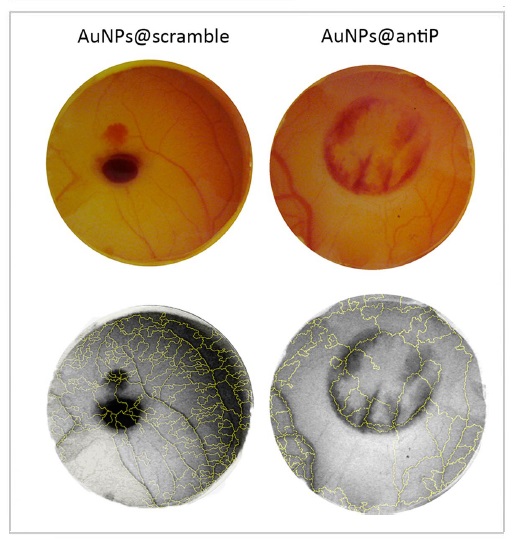Publications
Table of Contents (TOC)
Potentiating Angiogenesis Arrest In Vivo via Laser Irradiation of Peptide Functionalised Gold Nanoparticles
Journal of Nanobiotechnology, 2017, 15:85, 1–8
Abstract
Anti-angiogenic therapy has great potential for cancer treatment with several FDA-approved formulations, but considerable side effects on normal blood vessels limit their broader application. The chicken chorioallantoic membrane (CAM) model has been used to study angiogenesis in vivo. Using this model, it has been shown that spherical gold nanoparticles functionalised with an anti-angiogenic peptide can hamper neo-angiogenesis. Our results demonstrate that gold nanoparticles conjugated with an anti-angiogenic peptide, combined with visible laser irradiation, enhance angiogenesis arrest in vivo. We show that a green laser coupled with gold nanoparticles can achieve highly localized temperatures capable of precisely cauterizing blood vessels. This combined therapy acts via VEGFR pathway inhibition, leading to a fourfold reduction in FLT-1 expression. The proposed phototherapy extends the use of visible lasers in clinics, combining them with chemotherapy to potentiate cancer treatment. This approach allows dose reduction of the anti-angiogenic peptide, minimizing side effects while destroying blood vessel supply critical for tumour progression.
For citation:
Pedrosa, P.; Heuer-Jungemann, A.; Kanaras, A. G.; Fernandes, A. R.; Baptista, P. V.
"Potentiating Angiogenesis Arrest In Vivo via Laser Irradiation of Peptide Functionalised Gold Nanoparticles"
J. Nanobiotechnol. 2017, 15:85, 1–8. DOI: 10.1186/s12951-017-0321-2